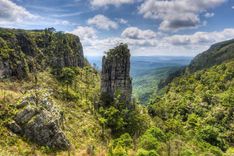25. iSimangaliso Wetland Park
iSimangaliso Wetland Park covers more than 820,000 acres (332,000 hectares) of protected coastline, where lakes, forests, coral reefs, and beaches all run into each other.
It’s one of the few places where you can see hippos and crocodiles at Lake St. Lucia, sometimes right from the elevated boardwalks. Leatherback and loggerhead turtles come ashore here to nest, while humpback whales pass just offshore.
The coastline is edged with massive forested sand dunes (some of the tallest in the world) where you might spot rare samango monkeys. Cape Vidal is popular for snorkeling, with colorful fish darting over the southernmost coral reefs, and anglers head offshore for deep-sea fishing right at the edge of the continental shelf.
The park’s name, iSimangaliso, means “miracle and wonder” in isiZulu, which feels fitting once you’ve seen how much is packed into this one protected area.
How to get to iSimangaliso Wetland Park
The town of St. Lucia is the main gateway, about three hours north of Durban on the N2. Several entrance gates lead into different parts of the park, so a rental car is the easiest way to get around. You can also take a boat tour from the St. Lucia estuary. The closest airport is Richards Bay, about an hour and a half away.
When to visit iSimangaliso Wetland Park
What you see depends on the season. From November to March, turtles are nesting and the Indian Ocean is warm enough for long swims. June through November is when humpback whales pass along the coast. December and January are the busiest months for local holidaymakers, so expect more people on the beaches. Birdwatching is good all year, especially in summer when migratory birds arrive.































